Serum Amyloid A (SAA) - Magnetic Particle Chemiluminescence Method (Acridinium Ester)/Fluorescence Immunochromatography Solution
Time:2024-03-18 Hits:217
Project Background
Serum amyloid A (SAA) is an acute-phase reaction protein with a relative molecular weight of approximately 12kD. It is primarily synthesized by liver cells and also produced in extrahepatic tissues such as the heart and skeletal muscles. Human SAA comprises SAA1, SAA2, SAA3, and SAA4. Based on expression in the human body, the SAA1 and SAA2 genes synthesize SAA1 and SAA2 proteins, collectively known as acute-phase SAA (A-SAA). The SAA3 gene is not expressed in the human body, and the SAA4 gene synthesizes constitutive SAA (C-SAA), which exhibits low expression levels in the liver. The concentration of C-SAA does not change with pathological (disease) alterations. In the acute-phase reaction, A-SAA rises rapidly in response to stimulation by interleukin I (IL-1), interleukin 6 (IL-6), and tumor necrosis factor (TNF). Its concentration can begin to increase 3 to 6 hours after infection, reaching levels 100-1000 times higher than the initial concentration. With a half-life of approximately 50 minutes, SAA decreases rapidly after recovery from the disease. In clinical diagnosis, SAA levels serve as sensitive indicators reflecting infectious diseases, aiding in infection diagnosis, disease assessment, and outcome prediction.
Performance
2.1 Chemiluminescence (Acridinium Ester) Platform
Combination: Carboxyl magnetic beads coated with Serum Amyloid A (SAA) antibody (Cat. No.: EKY0135K) + Serum Amyloid A (SAA) antibody (Cat. No.: EKY0135L) labeled with acridinium ester.
Linear Range: 1.5mg/L-200mg/L.
No evidence of a high-dose hook effect (HOOK effect) was observed when the sample concentration value was within 3000 mg/L.
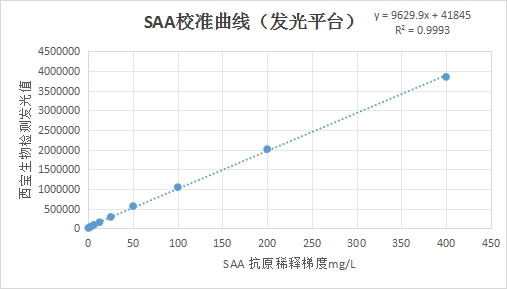 >
> Chemiluminescence (Acridinium Ester) Platform Calibration Curve
2.2 Fluorescence Immunochromatography (Lanthanide Eu Chelate Filling) Platform
Combination: Fluorescent microspheres labeled with Serum Amyloid A (SAA) antibody (Product No.: EKY0135I) + Serum Amyloid A (SAA) antibody (Product No.: EKY0135F) for streaking.
Linear Range: 5mg/L-200mg/L.
No evidence of a high-dose hook effect (HOOK effect) was observed when the sample concentration value was within 2000mg/L.
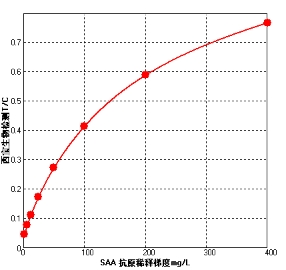 >
<
>
<Calibration Curve for Fluorescence Chromatography Platform
Clinical Relevance
3.1 Chemiluminescence (Acridinium Ester) Platform
The correlation between the SAA antibody pairing of Seebio Bioluminescence Platform and the clinical samples in the low-value part (≤90 mg/L) is related with R²>0.95, suggesting a good correlation.
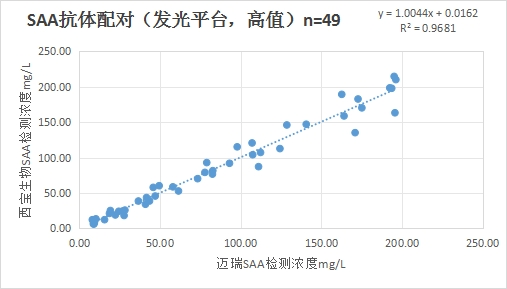
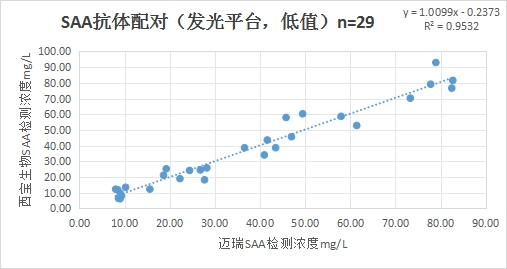
3.2 Fluorescence Immunochromatography (Lanthanide Eu Chelate Filling) Platform
The correlation between the SAA antibody pairing of Seebio Biofluorescence Platform and the clinical samples in the low-value part (≤90 mg/L) is related with R²>0.95, suggesting a good correlation.
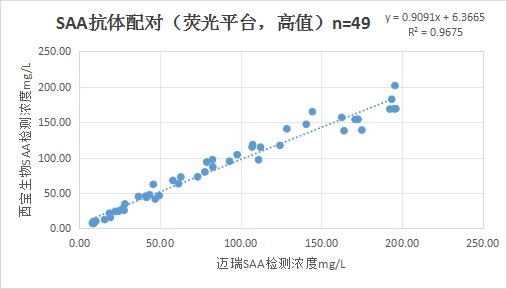
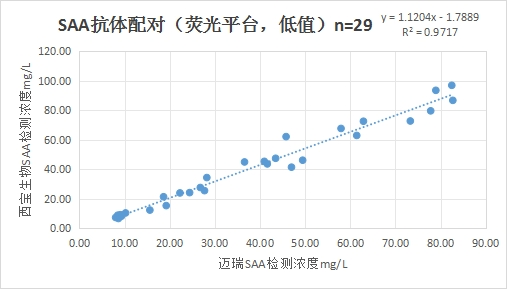
Test Plan
4.1 Chemiluminescence (Acridinium Ester) Platform
Antigen to be tested: SAA antigen (Cat. No.: EKY0139A or EDD0412A).
Dilute the sample/calibrator 1000 times with an appropriate diluent.
Sample/calibrator: Pre-diluted sample volume: 10ul.
Reagent 1: Serum amyloid A (SAA) antibody (Cat. No.: EKY0135K) coated-magnetic bead dilution, dosage 50ul/test.
Reagent 2: Serum amyloid A (SAA) antibody (Cat. No.: EKY0135L) labeled-acridinate dilution, dosage 50ul/test.
Luminescence instrument used in the test: Cosmai SMART 500S; a chemiluminescence instrument compatible with various acridinium ester systems (e.g., Sichuan Mike, Shenzhen Yahuilong, Shandong Kanghua Bio, Getein Bio, Nanjing Norman, etc.).
4.2 Fluorescence Immunochromatography (Lanthanide Eu Chelate Filling) Platform
Antigen to be tested: SAA antigen (item number: EKY0139A or EDD0412A), sample/calibrator: adding volume: 3ul.
Reaction conditions: Mix sample + fluorescent solution (sample is diluted about 400 times), load sample, reaction time (10min-15min).
Fluorescence instrument used for testing: Hemai FIC-S100; an instrument compatible with various fluorescence systems (excitation wavelength 365nm, emission wavelength 615nm), such as Guangzhou Labsim.
5. Product Information
|
Product
|
Item number
|
Recommended pairing
|
|
Serum amyloid A (SAA) antibodies
|
EKY0135K
|
Serum amyloid A (SAA) antibody (Cat. No.: EKY0135K) coated carboxyl magnetic beads + serum amyloid A (SAA) antibody (Cat. No.: EKY0135L) labeled acridinium ester(Luminous Pairing Set)
Serum amyloid A (SAA) antibody (Cat. No.: EKY0135I) labeled fluorescent microspheres + serum amyloid A (SAA) antibody (Cat. No.: EKY0135F) streaking(Fluorescence pair combination)
|
|
Serum amyloid A (SAA) antibodies
|
EKY0135L
|
|
|
Serum amyloid A (SAA) antibodies
|
EKY0135I
|
|
|
Serum amyloid A (SAA) antibodies
|
EKY0135F
|
|
|
Serum amyloid A (SAA) recombinant antigen
|
|
|
|
Serum amyloid A natural antigen
|
|
|
|
Serum amyloid A (SAA) antibody (Cat. No.: EKY0135K)-carboxy magnetic bead concentrate
|
DKY1320A
|
|
|
Serum Amyloid A (SAA) Antibody (Cat. No.: EKY0135L)-Acridinium Ester Concentrate
|
DKY1320B
|
|
|
Serum amyloid A (SAA) antibody (Cat. No.: EKY0135I)-labeled fluorescent microsphere concentrate
|
DKY1320C
|
|
|
Carboxy magnetic beads (superparamagnetic), 1um
|
DEG0091B-1-100mg
|
|
|
Carboxy magnetic beads (superparamagnetic), 3um
|
DEG0091A-3-100mg
|
|
|
Time-resolved fluorescent microspheres, carboxyl (200nm)
|
>
|
